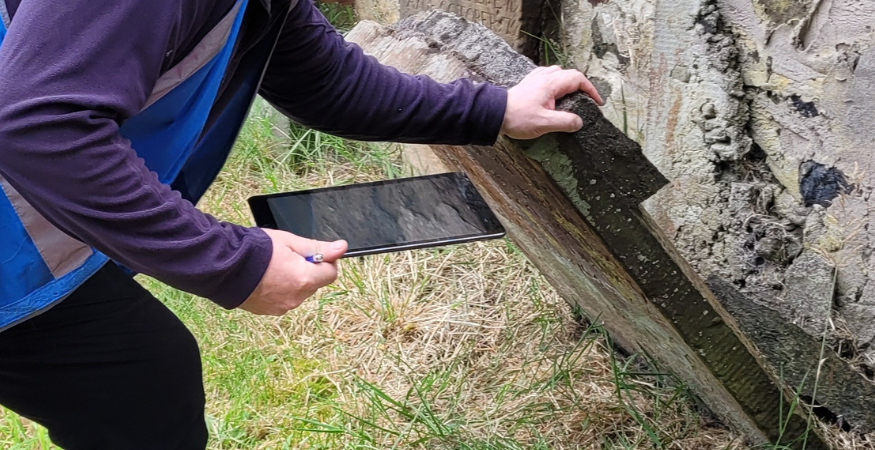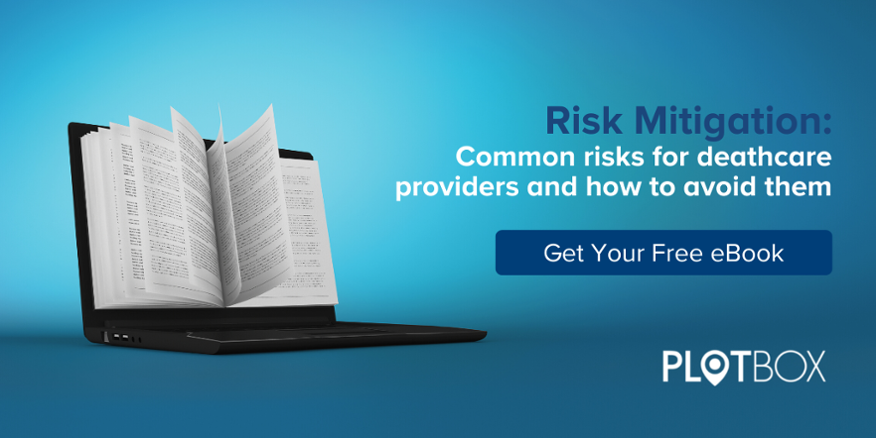| Read time: 7 mins
Whether falling under governmental legislation, such as the Local Authorities Cemeteries Order 1977 in England and Wales, the state level regulations across the US, or the Cemetery and Crematoria Acts in Australia supported by state regulations, the rules, laws and regulations pertaining to cemeteries and crematoriums globally, remind us of the myriad of factors deathcare providers must consider in order to remain compliant.
Alongside that, the codes of practice and guidance issued by bodies, associations and institutions helping to inform and steer the policies and procedures that promote and champion best practice.
The challenge for many - in both compliance practices and adhering to best practice - can come when reliant on disjointed, paper-based systems, and changes in record-keeping over time. Not only can this lead to low confidence in data held, but together, can make it more difficult to maintain, access and utilize the information held to optimal effect.
It’s therefore important to have access to the right information in the right place at the right time.
That means creating a ‘single source of truth’ - a single destination for all of the data held by your organization, providing a single point of reference for all. Without it, as we often say, deathcare professionals become more like detectives, piecing together sometimes conflicting information, with routine tasks often taking much longer than they need to.
With that in mind, we look at just a few of the ways in which a cloud-based deathcare management solution, such as PlotBox can help.
1. Mapping and inventory
In a recent blog, we looked at why accurate maps are important for Local Authorities, and the same may be applied more broadly, where under certain regulations accurate plans and cemetery burial records must be maintained showing a range of information including plot numbers, burials, rights, grave spaces etc.
In short, it’s imperative for cemetery operators in terms of compliance practices to know who is buried where at all times, and to be able to access that information when they need it.
With old paper maps that may have been based on surveys taken years prior, manually overwritten, and in deteriorating condition, complete confidence in the information you hold isn’t always guaranteed.
From a legal standpoint, that may even pose risk in terms of issues such as mislocated graves, wrong grave openings, markers or monuments installed at wrong graves, or double-sold plots.
In terms of best practice, linking your mapping information to digital records enables you to quickly and easily see exactly who is buried in a plot, along with related information, including ownership, digitized paper records, and even headstone images. From a compliance point of view, a full history of each record telling you who did what, where, when and how, also provides you with even greater accountability.
PlotBox’s verified mapping process utilizes high resolution aerial drone imagery to create a truly digital cemetery burial plot map, along with a forensic audit of your inventory, with real time status ensuring that what is on the ground matches exactly what you have in the office.

2. Record Keeping
While specific regulatory requirements may vary, as mentioned, maintaining permanent, accurate registers or cemetery burial records on information relating to interment places, rights, ownership etc. are fundamental to compliance practices.
In some cases, it is necessary that these are cross-referenced to cemetery plans or maps, be made available for inspection, and also, as in the case of the Local Authorities Cemeteries Order 1977 (Article 12) stored “...as to preserve them from loss or damage…”.
Cemeteries, crematories and funeral homes can be heavily reliant on paper, and with that comes a number of challenges. Information stored in old, deteriorating books and ledgers, stretching back decades may not be considered the most secure, accurate or efficient method of maintaining and preserving records.
As we increasingly move online, and as regulations evolve to meet changing expectations, the best enabler to keep your records secure, accurate and easily accessible is to store them electronically.
PlotBox’s Document Management module allows you to store scanned images of your important documents - including old maps, lot cards, book registers, and link them to your electronic records for quick and easy cross-referencing.
Also, in terms of record-keeping, paper-based systems can also pose a challenge when it comes to accessing and producing the information needed to file required reports - for example, annual financials, or monthly cremation reports. Pulling that information from a number of different sources may not only be time consuming but can also be prone to error.
A single deathcare management solution such as PlotBox can allow you to access a wide range of reports covering many aspects of cemetery and crematory management: from sales and financial, to inventory, operations and more.
From a best practice point of view, access to that level of detail can also help to make data-driven decisions - viewing operational data for example, can help tailor processes to make them more efficient, or gaining a clearer view of inventory, can help manage and maximize available space.

3. Manage Risk
Having touched briefly on risk for cemeteries in terms of inaccurate records or loss of information, let’s look at risk in terms of health and safety and liability.
As public spaces, cemeteries pose a number of risks to health and safety - both to employees and those who visit them; whether that’s toppled or unsecure monuments, overhanging tree limbs, cracked paths, benches in disrepair, etc. - all of which, if overlooked, may leave you exposed to legal action.
Whether adhering to cemetery policy and procedures, industry standards or regulations (in the UK, for example, compliance with British Standard 8415 states memorials are to be inspected a minimum of five years), regular safety checks and risk assessments will form an important part of that ‘making safe’ process.
Getting ahead of an issue before it arises is key to helping you to manage risk, and in terms of best practice, that means knowing the condition of your memorials and other features at all times, where they are, when their risk assessments are due, and having the processes and systems in place to ensure the appropriate measures are carried out in good time.
PlotBox’s Risk Assessment module will allow you to run status reports showing when plots are due their next risk assessment, as well as showing a risk assessment history on each plot record, helping to ensure you are fully compliant and up to date.
Assessments can be carried out onsite via the PlotBox app and images of work carried out can be uploaded to highlight measures taken and inspect work carried out, making the process much more efficient.
4. Grounds Maintenance
Whether falling within standards of practice, cemetery policy, or codes of regulation, (for example, as under the Cemetery and Funeral Bureau California Code of Regulations), adherence to minimum cemetery maintenance standards is often an important issue of compliance for cemetery operators.
That can range from mowing grass or pruning bushes, to ensuring pathways or roadways are cleared, refilling or resetting settled graves, basic repairs and everything in between.
Ensuring that work is carried out in a timely and efficient way relies on the ability to plan, prioritize and communicate effectively with your grounds crew. Managing that process can be time consuming, difficult to manage and even prone to error when reliant on paper-based work order systems.
The result can sometimes be poor communication leading to wrong or incomplete work, misplaced paperwork, higher costs, and duplication of effort.
The lack of evidence of work history can also provide difficulty when required to produce paperwork or reports for the purposes of audit. Read more about managing work orders here.
The solution is to implement an online work order system that allows you to plan and carry out daily tasks more efficiently and create smarter workflows. Linking your work orders to an online mapping tool will also show exactly where the work needs to be carried out, removing any room for doubt.
The PlotBox Work Orders module allows you to generate work orders from customized drop down lists, then assign, track and update job status in real time to help ensure compliance with service level agreements. Live dashboards provide quick reports showing exactly what’s happening and what needs to happen. Reviewing past times taken to carry out work and monitoring productivity will also help you to better organize your day’s work and schedule more efficiently.
Like to know more on risk mitigation? Download our eBook today:

